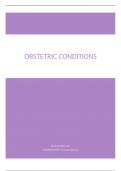Summary
Summary Obstetric summaries
- Course
- Institution
- Book
Summary of obstetric conditions and complications as covered in zero to finals. Contains information about clinical features of each condition, as well as relevant diagnostic tests and investigations, risk factors, causes and management guidelines. Everything has been cross referenced with passme...
[Show more]




